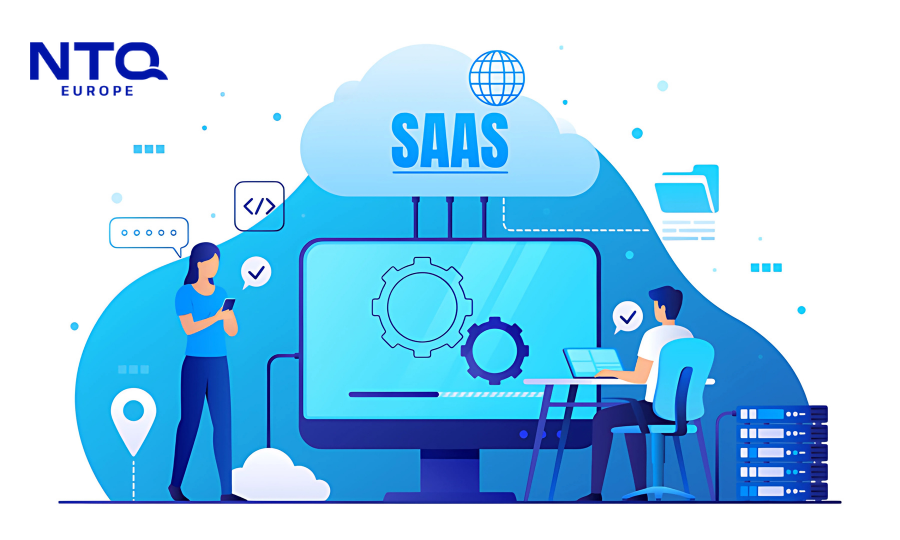Learn how Application Managed Services cut IT costs, improve performance, strengthen security, and drive business growth through expert app management.
1. Introduction to Application Managed Services
What is Application Managed Services?
Application Managed Services (AMS) is a long-term service model where a dedicated team continuously ensures that enterprise applications remain responsive to business change — even after they’ve been deployed. Rather than treating software as something that’s “done” after go-live, AMS recognizes that applications need to evolve alongside the business. It focuses on keeping the software environment stable while making ongoing adjustments to meet shifting needs, whether from users, processes, or external factors like regulations or market trends.
The Strategic Role of AMS in Enterprise Operations
For enterprises operating in competitive markets like Europe, the availability, performance, and security of applications directly impact operation, customer satisfaction, and revenue. Enterprise Application Management is no longer a luxury—it’s a necessity.
AMS providers enable companies to:
- Maintain high levels of application uptime and reliability.
- Ensure compliance with security and regulatory standards.
- Scale operations without compromising performance.
- Integrate new technologies like AI and cloud seamlessly into their existing systems.

How AMS Differs from Traditional IT Services
While traditional IT services may offer basic support such as incident resolution or infrastructure monitoring, Managed Application Services go several steps further. Here’s how AMS stands apart:
| Criteria | AMS (Application Management Services) | Traditional IT Services |
| Scope | Managing and optimizing enterprise applications | Managing IT infrastructure and general IT support |
| Objective | Optimize business processes and deliver business value | Ensure system stability and operational continuity |
| Approach | Proactive, SLA-based, continuous improvement | Reactive, issue-based, on-demand |
| Delivery Model | Long-term contracts, possibly including offshore teams | Short-term or project-based engagements |
| Value Orientation | Focused on business outcomes and innovation | Focused on system uptime and technical reliability |
| Expertise | Application-specific (e.g., SAP, Oracle, Salesforce) | General IT (networks, hardware, support systems) |
In short, AMS transforms application management from a cost center into a competitive advantage.
2. Common Challenges Without Application Managed Services

Many firms continue to handle their applications internally. However, this method frequently leads to inefficiencies and hazards that can be avoided with Application Outsourcing Services. Here are some of the common pitfalls:
High Costs of In-House Application Management
Maintaining a fully internal team to manage enterprise applications can lead to significantly high operational costs. Organizations must invest in hiring, training, and retaining specialized staff while also bearing infrastructure and licensing expenses. This model often lacks scalability and may not deliver continuous value, especially for businesses facing budget constraints or fluctuating workloads.
Performance and Security Gaps
Applications that are not consistently monitored and optimized can suffer from slow response times, system crashes, and security vulnerabilities. These issues can have serious business implications—ranging from lost sales to compliance violations.
AMS providers offer robust Application Management Services that include:
- Real-time performance tracking.
- Automated vulnerability scanning.
- Scheduled patching and updates.
- End-to-end encryption and secure integrations.
Lack of Skilled Resources
Enterprise applications like SAP, Oracle, or Microsoft Dynamics require specialized skills that are both rare and hard to retain internally. Without AMS, businesses often face knowledge gaps, delays, and over-reliance on a few key staff. As top application professionals pursue opportunities with consulting firms or flexible contract work that offer higher compensation and more diverse experiences, maintaining high-quality support in-house becomes a growing challenge.
Impact of Downtime on Business Continuity
Without Application Managed Services, downtime becomes harder to prevent and slower to resolve. When critical applications go offline, even briefly, business operations can come to a standstill tới Employees và customers. Over time, repeated disruptions erode trust, damage brand reputation, and lead to financial loss. Without proactive monitoring, rapid incident response, and structured recovery processes, business continuity remains at constant risk.
3. Key Features of Application Managed Services
Unlike one-time implementation support or traditional IT maintenance, AMS delivers long-term value by actively monitoring in real time and ready for what’s next.

Performance Monitoring and Optimization
Through advanced monitoring tools and AI-driven analytics, AMS providers keep a close eye on key performance indicators such as response times, uptime, memory usage, and user experience.
This data is used to:
- Identify bottlenecks in real-time.
- Optimize application workloads.
- Predict and prevent performance degradation.
The result? Always-on, high-performing systems that serve your business reliably.
Security and Compliance Management
Cybersecurity is non-negotiable. AMS providers implement end-to-end security protocols—from secure coding practices and vulnerability scanning to incident response and regulatory compliance checks.
Whether your business must comply with GDPR, HIPAA, PCI-DSS, or ISO standards, a good AMS partner ensures that your Application Managed environment remains fully compliant and resilient to threats.
24/7 Technical Support and Incident Management
Around-the-clock support isn’t just about being available — it’s about being prepared. True 24/7 coverage requires a system that’s actively watching, not waiting. Through a mix of global teams and automated monitoring, AMS ensures that incidents are not only detected instantly but handled without delay. It’s this constant state of readiness — not just presence — that makes continuous support possible.
Upgrades and Preventive Maintenance
Applications that aren’t upgraded regularly become outdated, incompatible, and vulnerable. AMS providers schedule timely updates and maintenance cycles to:
- Incorporate new features.
- Fix bugs and security holes.
- Ensure compatibility with evolving platforms and APIs.
This keeps your digital environment future-ready.
Integration and Scalability Support
As businesses grow, their systems need to talk to each other — and keep talking, even as everything changes. That’s where AMS becomes critical. Without ongoing support, integrations break, data gets stuck, and new tools can’t be adopted smoothly. AMS ensures that your applications stay connected and flexible so your business can scale with the technical foundation and continuity needed to keep that growth smooth and future-proof.
4. Benefits of Implementing Application Managed Services

Adopting Application Managed Services can have transformative effects across an organization’s IT operations and strategic direction. Below are some of the most impactful business benefits:
Reduced IT Operational Costs
Maintaining an in-house workforce to administer and support essential company systems can soon become prohibitively costly. Expenses add up, from salaries and continuous training to infrastructure maintenance and inefficiencies induced by delayed issue resolution.
By shifting to Enterprise Application Management Services, companies move from a CapEx-heavy model to a more predictable OpEx structure. Instead of investing heavily in fixed internal capacity, businesses pay for what they use — gaining access to specialized expertise, automation tools, and 24/7 support without the overhead. This frees up capital for strategic innovation while ensuring applications remain stable, secure, and performance-ready.
Enhanced Application Performance
AMS improves application performance by continuously monitoring system behavior and identifying issues before they impact users. Instead of waiting for something to break, Managed Services teams use real-time data and performance baselines to detect slow queries, overloaded components, or memory leaks — and fix them early. This proactive approach ensures that applications stay fast, stable, and ready to scale, even under changing business conditions or traffic spikes. The result is not just smoother performance, but fewer disruptions and a better experience for both users and IT teams.
Strengthened Security and Compliance
Security breaches and data leaks have become all too common—and expensive. AMS teams prioritize cyber hygiene by:
- Performing regular vulnerability assessments.
- Applying security patches and updates on time.
- Ensuring alignment with compliance frameworks (e.g., GDPR, HIPAA).
Thanks to these efforts, companies can protect sensitive data, preserve customer trust, and avoid legal penalties—all while maintaining their Enterprise Application Management at optimal levels.
Refocus on Core Business Objectives
Running an internal application support team can often distract from a company’s primary mission. By outsourcing these tasks to an expert AMS provider, business leaders can:
- Eliminate day-to-day operational distractions.
- Reallocate resources to innovation and strategic growth.
- Increase agility in responding to market trends and customer needs.
AMS thus becomes a strategic enabler, not just a support service.
5. How to Choose the Right Application Managed Services Provider
Choosing the right AMS partner is critical to long-term success. The market is full of vendors claiming end-to-end coverage, but how do you evaluate the right fit?
Evaluation Criteria for a Quality AMS Provider
When considering a provider of Application Management Services, assess them on the following:
- Domain Expertise: Do they have experience managing applications similar to yours (ERP, CRM, custom apps, etc.)?
- Technology Stack Support: Can they support your cloud environment (AWS, Azure, GCP) or hybrid architecture?
- Customization Capabilities: Will they tailor their services to your business needs or offer only standard packages?
- Scalability: Can their solution scale as your business grows?
The Role of Service Level Agreements (SLAs)
A robust Service Level Agreement (SLA) defines the expectations and accountability between you and your AMS partner. It should cover:
- Response and resolution times for incidents.
- Application uptime targets (e.g., 99.9%).
- Compliance and reporting standards.
- Penalties for underperformance.
Transparent SLAs not only reduce risk but also establish trust and clarity between both parties.
Role of AI, Cloud, and Automation in Modern AMS
Modern Application Outsourcing Services go beyond manpower—they harness the power of AI, cloud-native tools, and automation.
| Technology | Role in Modern AMS | Benefits |
| AI & Machine Learning | Analyzes usage patterns, detects anomalies, and predicts potential issues before they impact users. | Enables predictive maintenance, faster root cause analysis, and smarter decision-making. |
| Cloud Integration | Hosts applications in scalable, resilient environments; supports hybrid and multi-cloud setups. | Enhances flexibility, improves availability, reduces infrastructure cost. |
| Automation | Handles repetitive tasks like patching, monitoring, and incident response with minimal human input. | Reduces manual errors, shortens response times, and lowers operational workload. |
Together, these technologies redefine what’s possible with Managed Application Services.

6. Application Managed Services Solutions by NTQ Europe
At NTQ Europe, we understand that application performance is business performance. That’s why we’ve built a full-suite offering around Application Support and Maintenance that blends automation, intelligence, and human expertise.
End-to-End Managed Application Services
Our AMS solutions cover the entire application lifecycle:
- Performance monitoring and root cause analysis
- Security and compliance enforcement
- Bug fixing and updates
- Application modernization and cloud migration
- Third-party integrations and system scaling
We work seamlessly across both legacy and modern technology stacks, enabling clients to evolve without disruption. Whether you’re maintaining critical systems in manufacturing and logistics or scaling digital platforms in finance and retail, our AMS expertise ensures stability today — and adaptability for tomorrow.
AI-Driven Monitoring & Maintenance
By applying AI and machine learning into our Application Management Services, NTQ Europe delivers smarter, faster issue resolution. Our systems can detect anomalies before they impact users and trigger automated workflows to resolve them instantly. We combine this with human expertise to ensure even the most complex issues receive the right attention.
24/7 Global Support with Deep Expertise
Backed by a strong delivery team in Vietnam and dedicated client-facing operations in Europe, NTQ Europe provides true 24/7 support with both responsiveness and regional understanding. Our multilingual service desk operates around the clock to ensure that incidents are handled promptly, with tiered escalation, real-time monitoring, and SLA-based accountability.
7. Conclusion
As businesses accelerate digital transformation, enterprise applications are expected to do more than just function — they must adapt continuously, scale seamlessly, and stay secure in real time. The growing complexity of hybrid environments, rising compliance requirements, and the integration of AI & automation are making traditional, reactive IT models obsolete. Application Management Services are emerging as a long-term solution to meet these demands — offering not just operational stability, but the flexibility and intelligence needed for sustainable growth.
NTQ Europe is here to help you turn application management into a strategic advantage.



















